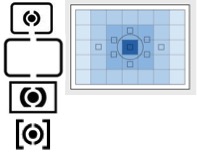Metering… in a very odd shaped nut shell….
In the early film days, camera did not have built in metering systems. Photographers would use handle-held light meters to aid them in determining proper exposure for the scene. They would set their aperture and have the light meter provide the shutter speed setting. Of course, they had to trust their light meters and gear because there was no opportunity to check an “LCD” to see if they got the shot. They may have had to wait weeks to see if the “nailed it”.
These days camera have some form of metering, this includes both film and digital cameras. The degree of complexity of the metering systems ranges from pretty simple in the early days to extremely sophisticated today, regardless of whether the camera is film or digital. For the purposes of this blog, I am going to focus on current day digital camera metering.
Metering is used to measure the brightness of your image and is how your camera determines the correct shutter speed in Aperture Priority or the correct aperture in Shutter Priority, depending on the ISO selected. If you are shooting in manual, the camera’s metering mode is not engaged, as you control the exposure directly. In Auto mode, the camera is selecting the aperture, shutter speed, and ISO depending fully on the metering mode selected. As an experiment, put your camera in aperture mode and for each metering mode available on your camera, look through the viewfinder (if you have an electronic view finder) or use the LCD (if you don’t) and point the camera to different light values in a scene. You will see how each metering changes the image based on where the camera is pointed (darks, shadows, midtones, whites, and highlights).
Understanding metering can help you determine the correct expsoure for the scene, as well as exercise your creative intent, often adding drama and interest to the scene straight out of camera, thereby lessening the post process effort.
Camera Manufacturer Metering Modes:
- Nikon, Sony, and Pentax have 3 metering modes: Spot, Center-Weighted, and Matrix.
- Canon has 4 metering modes: Spot, Center-Weighted, Evaluative (aka Matrix), and Partial.
- Fuji has 4 metering modes: Spot, Center-Weighted, Multi (aka Evaluative/Matrix), and Average.
- Olympus has 5 metering modes: Spot, Center-Weighted/Average, Digital ESP (aka Evaluative/Matrix/Multi), Spot Highlight, Spot Shadow.
Let’s discuss these modes in more detail. I have also provided some images to demonstrate the final results.
 Spot (Nikon, Canon, Fuji, Pentax, Sony) Metering – spot metering sets the exposure based on the light source on which the focus point or metering point is set. Most cameras meter based on the focus point. So if this light is brighter, the rest of the image tends to fall off and get darker. This mode looks at 2-4 % of the image area. Often the result can be quite dramatic.
Spot (Nikon, Canon, Fuji, Pentax, Sony) Metering – spot metering sets the exposure based on the light source on which the focus point or metering point is set. Most cameras meter based on the focus point. So if this light is brighter, the rest of the image tends to fall off and get darker. This mode looks at 2-4 % of the image area. Often the result can be quite dramatic.
For Olympus, there are two additional choices: Spot Highlight and Spot Shadow. Spot Highlight ensures bright subjects appear bright and conversely, Spot Shadow ensures shadows appear dark.
In my opinion, the results of all of the other metering modes tend toward more balanced light, with variations based on focal point or magnitude of the light in the area of analysis. Since I shoot Fuji, I will provide the descriptions of the metering modes and images that approximate the exposure for metering modes that are specific to other manufacturers.

CenterWeighted (Nikon, Canon, Fuji, Pentax, Sony) – This mode measures light across the entire image, placing more emphasis on the light in the center. Generally his mode doesn’t consider the focal point, but rather utilizes the same averaging pattern for each image.
 Matrix (Nikon/Pentax), Evaluative (Canon), Multi-Zone (Sony, Fuji) Metering – This mode measures the light across the entire image and considers the focal point, and it biases the exposure based on the light in the area of focus.
Matrix (Nikon/Pentax), Evaluative (Canon), Multi-Zone (Sony, Fuji) Metering – This mode measures the light across the entire image and considers the focal point, and it biases the exposure based on the light in the area of focus.
For Fuji, this mode determines the exposure based on an analysis of composition, color, and brightness distribution in the entire image.

Average Metering (Fuji) – This mode provides consistent exposure across multiple shots with the same lighting by setting the exposure to an average for the entire frame.
Partial Meteri ng (Canon) – This mode looks at a larger area inside a circle after the focal spot. So just evaluates more of the light in the image, looking at between 5-15% of the picture area.
ng (Canon) – This mode looks at a larger area inside a circle after the focal spot. So just evaluates more of the light in the image, looking at between 5-15% of the picture area.
Experiment with your metering modes and determine which ones provide you with the most creative options. For me, spot metering and center-weighted are my go to metering modes when shooting single images. I find when I get home I gravitate to images taken in these modes for processing single image scenes. Images taken in average or matrix result in flatter lighter, which I find better for when I composite images, because they let me control the direction of light in post process. Figure out your ideal metering mode and get creating!
![]()

















Georgette Grossman
18 Dec 2017Thanks for the detailed explanations (WITH IMAGES)!